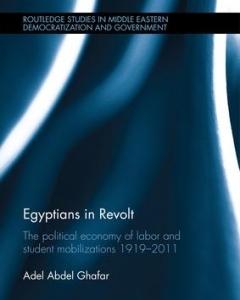
Abstract
Egyptians in Revolt investigates the political economy of the Egyptian labor and student movements. Using elements of social movement theory within a broad political economy framework, it assesses labor and student mobilizations in four eras of contemporary Egyptian history: the pre-1952 era, the Nasser era, the Sadat era and the Mubarak era.
Egyptians in Revolt examines how both student and labor groups responded to the political economy pressures of the respective eras. Within the context of social movement theory, the book argues that political opportunities and threats have had a significant impact on both student and labor mobilizations. In addition, the book explores how the movements have, at times, been able to affect government policies. However, the argument is made that the inability of both groups to sustain momentum in the long term is due to cooptation efforts by established political forces and the absence of viable and enduring organizational structures that are autonomous of state control.
By combining analysis to include both labor and student movements, Egyptians in Revolt is a valuable resource for understanding the Egyptian political economy and its impact on mobilizations. It will therefore be of interest to students and scholars of Middle East Studies, as well as those interested in social movement more broadly.